In the pink
Warning; this post contains beetroot. An interlude on chilled soups, sour cherries, and The best summer soup recipe.
Thank you for joining me today, I’m glad you’re here.
I’m aware that I’m probably turning away a percentage of you who think beetroot was invented by someone who hates you. It’s too earthy, too sweet, too; beetrooty. And you think they taste like dirt. For those of you still with me, I’m leading up to the best summer soup recipe.
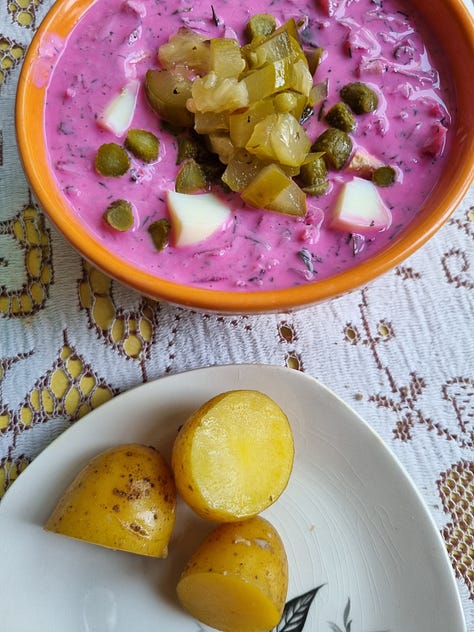
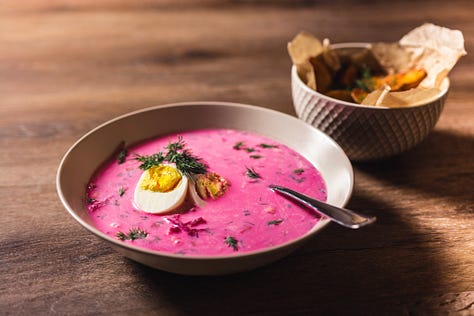

One hot sultry night two years ago, on a summer trip to Riga, I met up with friends from Los Angeles. They’d already dined when my late evening plane arrived but were happy to snack (that’s why we’re friends). In the old town we discovered a little restaurant still serving. To my delight they had cold beetroot soup on the menu. It was a deep pink colour, tangy with kefir and pickled cucumbers, fragrant with dill, and served with boiled egg and warm new potatoes on the side. To this day it’s one of the best things I’ve ever eaten.
There’s some distinction and rivalry between the soup in Lithuania (where it was invented) and in Latvia. The component ingredients are there; beetroot, cucumber and kefir. After that, the gloves are off. You may as well say that there is a definitive recipe for borscht.
In Lithuania šaltibaršči (pronounced “shull-tee-barsh-chay, which when I first wrote it down immediately made me think of the character from A Hitchhikers Guide to the Galaxy1) is eaten with boiled eggs in the soup and boiled or sauteed potatoes on the side. In Latvia the soup may contain sausage and is eaten with dark rye bread. Most everything is eaten with dark rye bread in Latvia. The soup I ate in Riga didn’t contain any sausage and was served the Lithuanian way.
Lithuania loves pink soup so much they launched a festival for it. This year it took place 31st May. Ist June when Vilnius transformed into a sea of pink. In its third year of vying with other European food based festivals like Spain’s La Tomatina but without the waste, over 10,000 people gathered to celebrate pink soup.


The Pink Waiters’ Run, inspired by Parisian coffee races has participants race through the city carrying bowls of pink soup while trying not to spill any. Cafés offer pink pizza and beetroot-based cocktails. Expect to find beetroot flavoured everything from ice-cream to coffee.
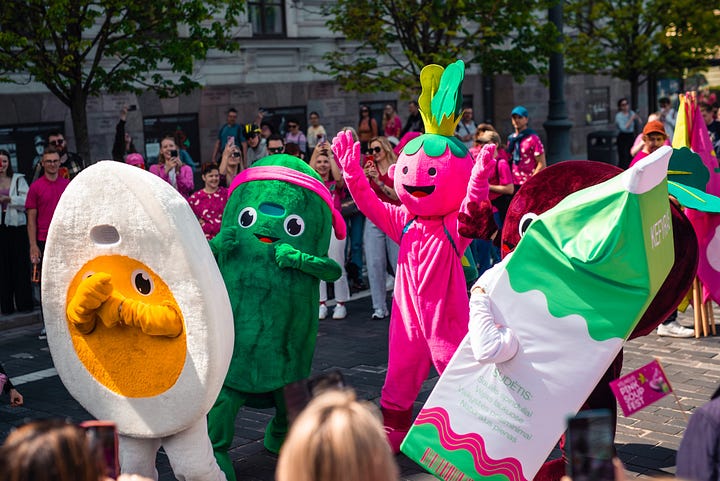



Even Vilnius Railway Station joined the celebration, turning pink and hosting special Pink Dinner events.
We found pink soup everywhere in Riga and Vilnius, from corner shops where you can buy a handy pouch of ready to eat pink soup, to restaurants and cafes. The festival launched its very own pink train this year, the route running between Riga and Vilnius until 10th August.
Chilled soups have an elegant history, sadly gone out of fashion, many people remaining suspicious of them. In the 1960s a chilled can of consommé would be served jellied and if you’re old enough to remember, jellied consommé was often used as a garnish instead of aspic. That’s enough to put anyone off chilled soups. I could quite easily go down a rabbit hole here with a whole post about aspic but I promise you I won’t.
The popularity of some chilled soups are on the rise again.We love gazpacho or Salmorejo, maybe even Swedish fruit soups often served as a sweet course, but other soups, such as Hungarian sour cherry soup, cucumber soup, even Vichyssoise seem to have faded out of view. Cherry soup needs sour cherries, not easy to find unless you live in Eastern Europe. Here’s a quick diversion to Krakow a few years ago, where this market had at least three varieties of cherries for sale, including the elusive sour morello.
And as it is cherry season, in case you missed it, here’s the post I wrote last year about cherries.
The pleasure of cherries
There’s the land or cherry-isle, Whose plantations fully show All the year where cherries grow
Back to beetroot…
Beetroot in tiny little dice were part of my infant school salad plate, with a sprig of watercress and a slice of gala pie. Funny the things one remembers. There was always a pyrex bowl of home-made pickled beetroot with sliced onions in the fridge at home, ready for salads or my favourite, a sandwich made with soft white bread and butter. I’d do very well in Australia where, as my Aussie readers know all too well, beetroot rules.
I use beetroot in everything from a pasta filling, in hummous, preserves and pickles, a bright pink risotto, to brownies and cakes (beetroot and poppy seed especially).
Beetroot turned up in one of my favourite children’s books, The Saturdays, even though I had no idea it was there. An American book, the foods they ate were alien to me; beets, rutabaga.
Beta Vulgaris, sea beet, has been known since prehistory, The ancient Greeks and the Romans cultivated leaf beets. The earliest Greek name for beet was teutlon or teutlion, probably because its foliage was thought to resemble squid tentacles.2 Boiled beetroot is referred to in the Talmud, which captures practices up through the fifth century CE.3
Whereas leaf beets were widely eaten, the root took longer to be accepted, with new varieties of bulb shaped rather than a thin tapered root being produced in the 15th and 16th centuries in Germany and Britain. From Germany, the popularity of beetroot spread across Eastern Europe and up to Scandinavia.

In the Victorian era, beetroot became popular as a salad vegetable. The juice of beetroot was also used as a hair rinse and a dye for fabric.4
The family tree includes beet greens; chards, and sugar beet, processed for sugar. The word I loved as a child, magelwurzel5, grown for animal feed is starting to make a come back as a culinary ingredient.
Beetroot is loved world over, from Guatemala, to Northern China where it’s eaten as a snack, pickled or raw.
The diversion in American English from beetroot to beet is harder to track. Elizabeth Fries Ellet, Henry Bill Publishing Company, 1872 – states;
“Beet-Root is a root of a plant which of late years has been extensively cultivated for the purpose of feeding cattle; the colour which it possesses is easily extracted, for the purpose of tinting various articles employed in cookery. When boiled, it is a beautiful addition to every salad.” 6
At some point in America, the word was shortened to beet whilst here in the UK we use beetroot, so we know we’re eating the root, and not the stems. Eliza Acton (1835) refers to ‘beet root’. To complicate matters, in 1932, in Good things in England, Florence White refers to the vegetable as ‘beets.’ In 1942, Constance Fry sang the praises of beetroot, giving a recipe for beetroot fritters as ‘a sort of vegetable fritto misto’ In 1954, Dorothy Hartley in Food in England uses both words, beet and beetroot.
According to BBC America; ‘It’s known in the U.S. simply as “beets” because Americans are busier than Brits and don’t have time for a second syllable.’
My recipe for Pink Soup
Whatever you do, don’t be tempted to buy one of those plastic shrink wrapped packs of cooked beetroot from a supermarket. They taste of nothing, and therefore your soup will taste of nothing. If you have one of those old fashioned green grocers or market stalls that still sell boiled beetroot, and wrap them in newspaper, pounce on them and never let them retire. I buy raw beetroot and cook in a pressure cooker. If I buy a bunch with leaves I’ll sometimes add the chopped cooked leaves to the soup (yes, heresy I know) or keep them for another dish.
A word about dill. I get annoyed when recipes ask for a tiny amount of fresh herbs, leaving you with most of a whole bunch languishing in your fridge because you forgot to use them up. Dill, if you can source it from a farmers market, market or Eastern European/International shop will often be sold as a huge generous bunch. It freezes beautifully. Separate the fronds from the stalks. Put into a bag, flatten, (don’t forget to label), freeze it all and crumble or chop into whatever you need.
And unless you want pink fingers, get out the washing up gloves to deal with the beetroot.
Ingredients
Serves 4-6
1 litre kefir; I use ‘drinking kefir’ as it’s more liquid. If you can only find the kind in pots that looks like yogurt, that’s fine too; just dilute it down with milk or water.
beetroot, about 300g, cooked, peeled and grated
5 tablespoons dill fronds, finely chopped
3 short cucumbers; middle Eastern, Persian or slender crooks, finely chopped. If all you have access to are standard long English cucumbers, use half, remove the seeds before chopping. The easiest way to do this, I find, is cut lengthwise in half, and use a small coffee spoon to scoop out the seeds.
2 medium sized pickled cucumbers, finely chopped
2-3 medium sized picked beetroot, grated
1 egg per person, hard boiled
New potatoes; about 3-4 per person
Boil the potatoes and keep warm. I tend to add the room temperature eggs to the same pan adding them in for the last 9 minutes of cooking time. Cool the eggs in cold water and chill.
In a large container that you can cover and fit in the fridge; combine the kefir with the grated fresh beetroot. Add the cucumber and dill and stir well. Add in half of the chopped pickled cucumber and beetroot, taste, then add seasoning. You may want to add more pickles. It should be piquant, and creamy. If you prefer a smooth soup feel free to blend.
Chill for at least an hour to let the flavours blend. Taste again. Add more dill, or pickles to your preference. Add a little lemon juice, pickle juice from the jars of beetroot or cucumber, or cider vinegar if you want to increase the piquancy.
Serve with chopped hard boil eggs, in each soup bowl, potatoes on the side and any remaining pickles, sprinkled on top. If it’s too thick, dilute with water or milk. Enjoy. It lasts, if it’s not eaten at once, about 3-4 days in the fridge.
Variations; use all pickled cucumbers, no fresh. Use all pickled beetroots, no fresh. Play around with what suits your taste buds.
Queen of Markets is written by Cheryl Cohen. Posts are free to read two-three times a month and you can follow me on Instagram. If you’d like to read more, you can subscribe for £5 a month or £50 a year for extra content. Thank you very much for being here.
As (2)
As (3)






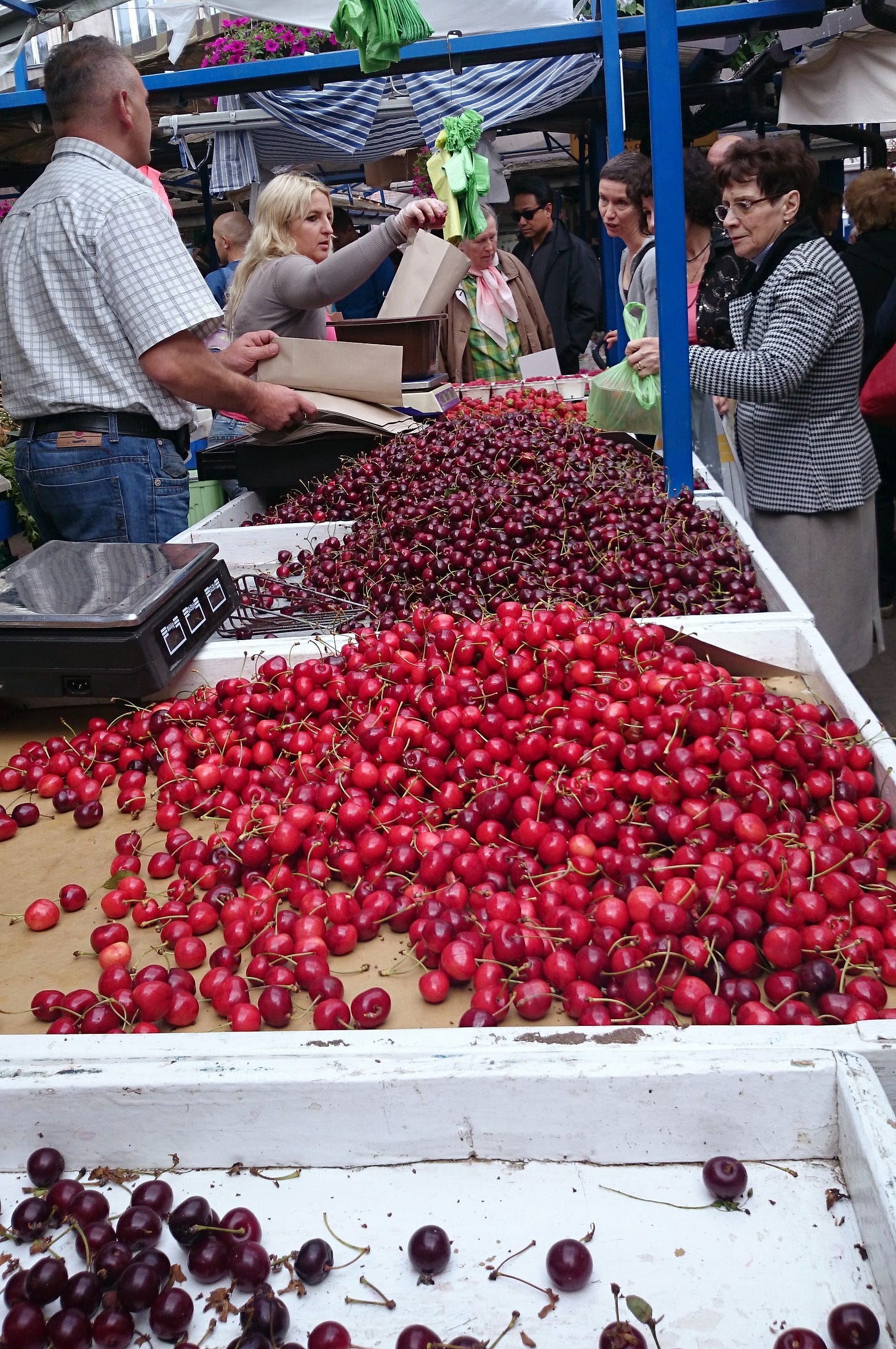

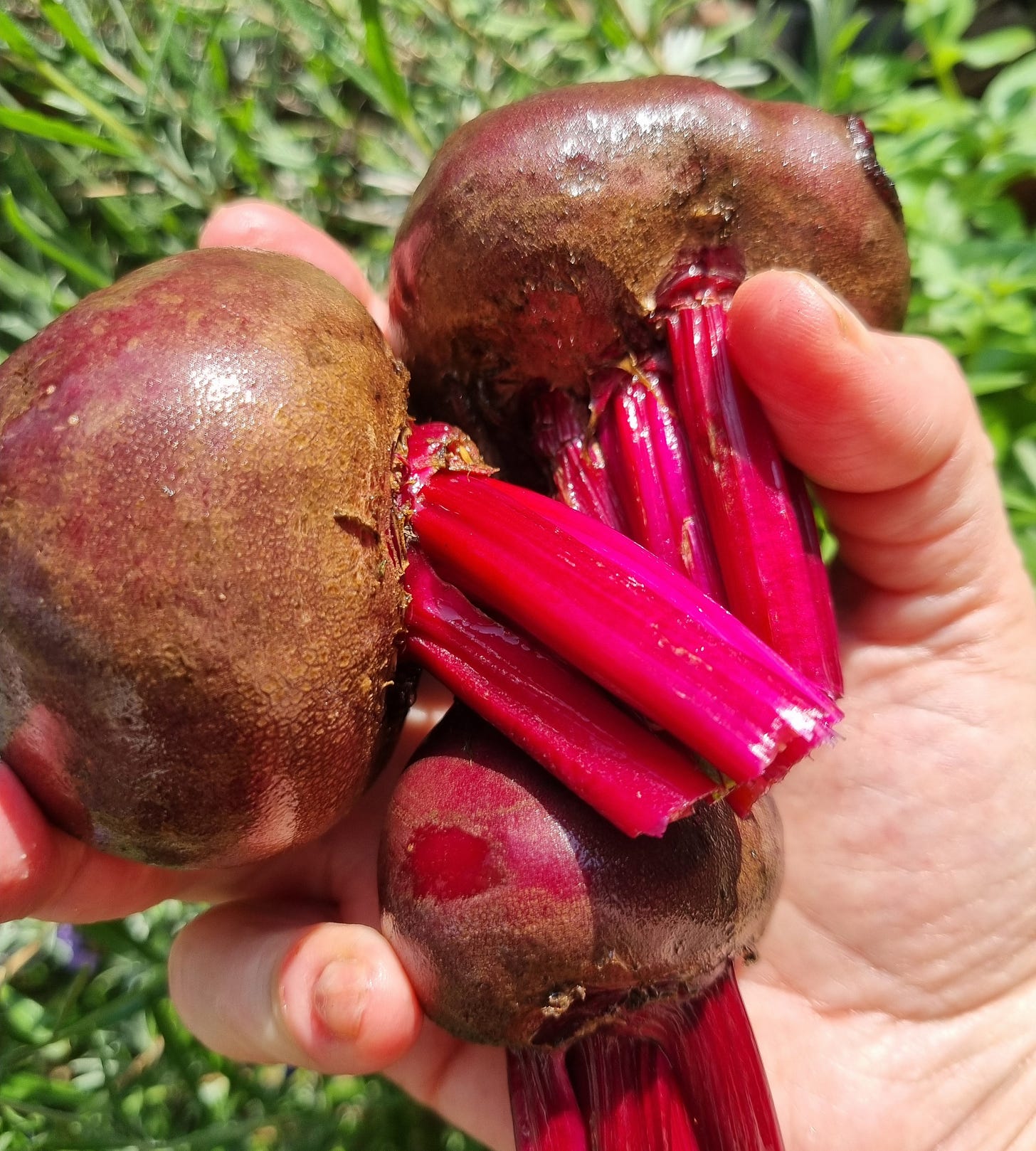
I'm a big fan of beetroot and love a beetroot risotto.
Slartibartfast soup! Love it. Also made me remember that when my cousins and I were small, we’d have a chopped salad for Saturday tea at our grandparents’ house (while the adults went to football matches). We’d always chop up pickled beetroot and mix the veggies with that and copious amounts of salad cream to make pink salad. I probably wouldn’t eat it now, but it was our treat to be allowed to do it.